
The Boletaceae are a family of mushroom-forming fungi, primarily characterised by small pores on the spore-bearing hymenial surface, instead of gills as are found in most agarics. Nearly as widely distributed as the agarics, the family is renowned for hosting some prime edible species highly sought after by mushroom hunters worldwide, such as the cep or king bolete . A number of rare or threatened species are also present in the family, that have become the focus of increasing conservation concerns. As a whole, the typical members of the family are commonly known as boletes.
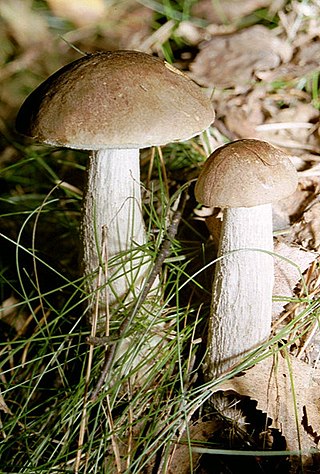
Leccinum scabrum, commonly known as the rough-stemmed bolete, scaber stalk, and birch bolete, is an edible mushroom in the family Boletaceae, and was formerly classified as Boletus scaber. The birch bolete is widespread in Europe, in the Himalayas in Asia, and elsewhere in the Northern Hemisphere, occurring only in mycorrhizal association with birch trees. It fruits from June to October. This mushroom is also becoming increasingly common in Australia and New Zealand where it is likely introduced.

Trypaea australiensis, known as the (marine) yabby or ghost nipper in Australia, or as the one-arm bandit due to their occasional abnormally large arm, and as the Australian ghost shrimp elsewhere, is a common species of mud shrimp in south-eastern Australia, and may be the only extant species in the genus Trypaea. T. australiensis is a popular bait used live or frozen by Australians targeting a range of species. It grows to a length of 6 centimetres (2.4 in) and lives in burrows in mudflats or sandbanks, especially in or near estuaries.

Boletus is a genus of mushroom-producing fungi, comprising over 100 species. The genus Boletus was originally broadly defined and described by Carl Linnaeus in 1753, essentially containing all fungi with hymenial pores instead of gills. Since then, other genera have been defined gradually, such as Tylopilus by Petter Adolf Karsten in 1881, and old names such as Leccinum have been resurrected or redefined. Some mushrooms listed in older books as members of the genus have now been placed in separate genera. These include such as Boletus scaber, now Leccinum scabrum, Tylopilus felleus, Chalciporus piperatus and Suillus luteus. Most boletes have been found to be ectomycorrhizal fungi, which means that they form a mutualistic relationship with the roots system of certain kinds of plants. More recently, Boletus has been found to be massively polyphyletic, with only a small percentage of the over 300 species that have been assigned to Boletus actually belonging there and necessitating the description and resurrection of many more genera.

Leccinum is a genus of fungi in the family Boletaceae. It was the name given first to a series of fungi within the genus Boletus, then erected as a new genus last century. Their main distinguishing feature is the small, rigid projections (scabers) that give a rough texture to their stalks. The genus name was coined from the Italian Leccino, for a type of rough-stemmed bolete. The genus has a widespread distribution, especially in north temperate regions, and contains about 75 species.
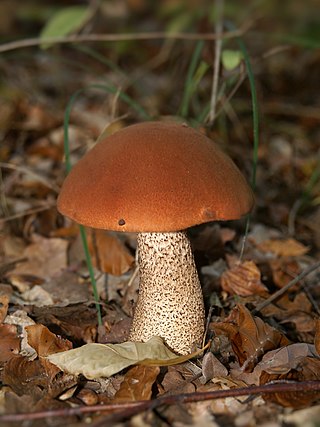
Leccinum aurantiacum is a species of fungus in the genus Leccinum found in forests of Eurasia and North America. It has a large, characteristically red-capped fruiting body. In North America, it is sometimes referred to by the common name red-capped scaber stalk. Some uncertainties exist regarding the taxonomic classification of this species in Europe and North America. It is considered edible, but must be cooked thoroughly.

Ovalipes australiensis is a species of crab found in southern Australia. Its range extends from Western Australia to Queensland, including Tasmania. It is fished commercially and recreationally, although it is not as important as the blue swimmer or mud crab.

Semecarpus australiensis, commonly known as the tar tree, native cashew, marking nut, or cedar plum, is a species of tree in the cashew, sumac and mango family Anacardiaceae, native to parts of Melanesia and northern Australia. Contact with the plant can cause serious allergic reactions, a common characteristic of this family.
Hemigaleus is a genus of weasel shark in the family Hemigaleidae. It is characterized by a rounded snout and short gill slits. The mouth is short and broadly arched; the teeth have very short cusps, without toothless spaces at the jaw midlines. The dorsal and pelvic fins, and the lower caudal lobe are strongly falchate. At one time or another, this genus has encompassed up to nine species, but most were eventually split off into other genera. Neogaleus Whitley, 1931 is a junior synonym of this genus.

Leccinum manzanitae is an edible species of bolete fungus in the family Boletaceae. Described as new to science in 1971, it is commonly known as the manzanita bolete for its usual mycorrhizal association with manzanita trees. Its fruit bodies (mushrooms) have sticky reddish to brown caps up to 20 cm (8 in), and its stipes are up to 16 cm (6.3 in) long and 3.5 cm (1.4 in) thick. They have a whitish background color punctuated with small black scales known as scabers. Found only in the Pacific Northwest region of the United States and Canada, it is the most common Leccinum species in California. The mushroom is edible, although opinions vary as to its quality. L. manzanitae can be usually distinguished from other similar bolete mushrooms by its large size, reddish cap, dark scabers on a whitish stipe, and association with manzanita and madrone.
George Bentham's taxonomic arrangement of Adenanthos was the first comprehensive taxonomic arrangement of that plant genus. It was published in 1870 in his landmark flora of Australia, Flora Australiensis. It would stand for over a hundred years before being superseded by the 1978 arrangement of Ernest Charles Nelson.

Sutorius is a genus of fungi in the family Boletaceae. Its type species is the widely distributed Sutorius eximius. The Asian Boletus obscureumbrinus, found in Japan and China, was described by Japanese mycologist Tsuguo Hongo in 1968, moved to genus Sutorius in 2016, but then reclassified into genus Neoboletus in 2019. The Australian Sutorius australiensis and the southern Chinese Sutorius subrufus also belong to the genus.
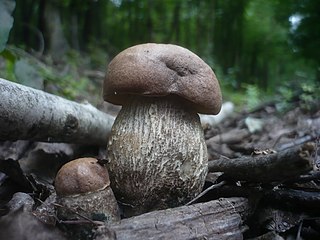
Leccinum duriusculum is a bolete mushroom in the genus Leccinum. Originally called Boletus duriusculus by Hungarian–Croatian mycologist Stephan Schulzer von Müggenburg in 1874, it was transferred to Leccinum by Rolf Singer in 1947.

Leccinum arenicola is a species of bolete mushroom in the family Boletaceae. Described in 1979, the fruit bodies (mushrooms) grow in sand dunes from New Brunswick south to Cape Cod.

Harrya chromapes, commonly known as the yellowfoot bolete or the chrome-footed bolete, is a species of bolete fungus in the family Boletaceae. The bolete is found in eastern North America, Costa Rica, and eastern Asia, where it grows on the ground, in a mycorrhizal association with deciduous and coniferous trees. Fruit bodies have smooth, rose-pink caps that are initially convex before flattening out. The pores on the cap undersurface are white, aging to a pale pink as the spores mature. The thick stipe has fine pink or reddish dots (scabers), and is white to pinkish but with a bright yellow base. The mushrooms are edible but are popular with insects, and so they are often infested with maggots.
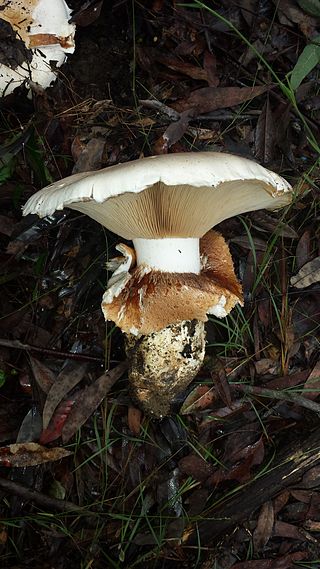
Austrocortinarius australiensis, commonly known as the skirt webcap, is a species of mushroom in the family Cortinariaceae which is native to Australia and New Zealand. The white mushrooms appear in autumn and can grow very large, with their caps reaching 30 cm (12 in) in diameter.

Sutorius eximius, commonly known as the lilac-brown bolete, is a species of fungus in the family Boletaceae. This bolete produces fruit bodies that are dark purple to chocolate brown in color with a smooth cap, a finely scaly stipe, and a reddish-brown spore print. The tiny pores on the cap underside are chocolate to violet brown. It is widely distributed, having been recorded on North America, South America, and Asia, where it grows in a mycorrhizal relationship with both coniferous and deciduous trees.
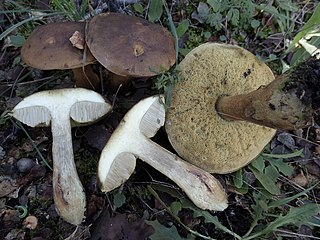
Leccinellum lepidum is a species of bolete in the family Boletaceae. Originally described as Boletus lepidus in 1965, the fungus has gone through controversial taxonomic treatments over the years and was subsequently transferred to genus Krombholziella in 1985, to genus Leccinum in 1990, and to genus Leccinellum in 2003. It is the sister-species of Leccinellum corsicum, with which it had been erroneously synonymised by some authors in the past.














